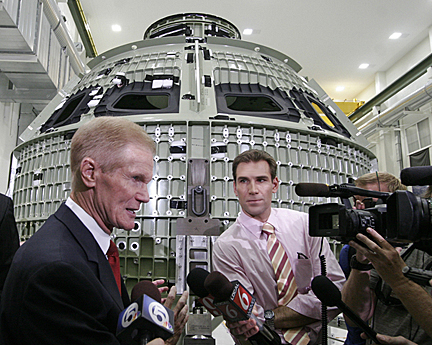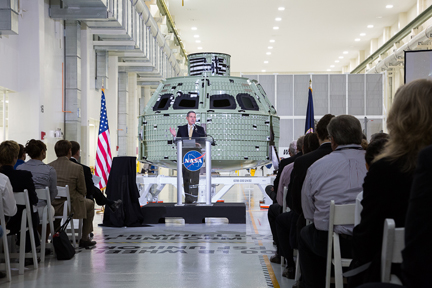NASA shows off first Orion capsule with KSC ceremony
By WILLIAM HARWOOD
CBS News
KENNEDY SPACE CENTER, FL--The first space-bound Orion capsule, the centerpiece of NASA's post-shuttle push to break out of low-Earth orbit for eventual manned flights to a variety of deep space targets, was officially unveiled at NASA's Florida spaceport Monday. The spacecraft will be outfitted for an unmanned test flight in 2014.
"As KSC celebrates its 50th anniversary this month, I can't think of a more appropriate way to celebrate than by having the very first Orion Multi-Purpose Crew Vehicle here at KSC," center Director Robert Cabana, a former shuttle commander, told more than 400 managers, engineers and technicians gathered at Kennedy's Operations and Checkout Building.
"Orion is ushering in a new era of space exploration beyond our home planet, enabling us to go farther than we've ever gone before. The future is here, now, and the vehicle we see here today is not a Powerpoint chart. It's a real spacecraft, moving toward a test flight in 2014."
Sen. Bill Nelson, the Florida Democrat who has led the congressional effort to build a new heavy lift rocket that will boost Orion into deep space, said the arrival of the first capsule is a symbol of things to come.
"Isn't this beautiful?" he said, standing before the empty pressure shell of the first test capsule. "I know there are a lot of people here who can't wait to get their hands and their fingers on this hardware. And ladies and gentlemen, we're going to Mars. Without question, the long-term goal of our space program, human space program right now is the goal of going to Mars in the decade of the 2030s.
"We still need to refine how we're going to go there, we've got to develop a lot of technologies, we've got to figure out how and where we're going to stop along the way. The president's goal is an asteroid in 2025. But we know the Orion capsule is a critical part of the system that is going to take us there."
The green interior pressure vessel that will make up the core of the first Orion capsule was delivered to Kennedy last week. Over the next year of so, engineers will attach a heat shield, install avionics systems and flight computers, along with other critical components. If all goes well, the capsule will be launched on an unmanned test flight -- Exploration Flight Test 1, or EFT-1 -- in 2014.
NASA is designing a new Saturn 5-class heavy-lift rocket known as the Space Launch System, or SLS, for future manned exploration missions into deep space using Orion capsules. But the first test flight in 2014 will be launched using a Delta 4 rocket built by United Launch Alliance.
The flight plan calls for the Delta 4 to put the Orion MPCV on a trajectory carrying it to an altitude of some 3,600 miles before it slams back into the atmosphere at more than 20,000 mph, roughly comparable to the velocities that will be experienced by astronauts returning from deep space missions.
"It's basically our very first uncrewed test," said astronaut Rex Walheim, a member of the final shuttle crew. "They're going to send it out to about 15 times the altitude of the space station so they can get a really good high re-entry velocity. Obviously, the farther you send something out, the faster it comes back. And that will really help us test out its heat shield and all the other systems that are on board to give us an idea about what we need to tweak, maybe, before the next flight test."
If that mission goes well, NASA managers hope to launch another unmanned Orion atop an SLS rocket in 2017 to characterize the performance of the system in an integrated test. A third flight in the 2021 timeframe will include a crew of up to four astronauts.
"I probably won't get a chance to fly (aboard Orion), but I just love being part of it," Walheim said. "It really inspires people, to talk about going beyond low-Earth orbit. It's something I really want to see us do."
But the Orion schedule assumes steady funding by Congress, which is an open question given the current debate over federal budget deficits, taxes and a general push to reduce federal spending.
"We have to be concerned about that because we are in an era of government spending where you have to do more with a limited amount," Nelson said. "That, of course, is going to be one of the main things we're going to have to look at in the future."
Along with developing new rockets and capsules for deep space missions, NASA also is funding development of commercial manned spacecraft intended to ferry astronauts to and from the International Space Station. The first manned test flight of a commercial spacecraft could come as early as 2015. But the first NASA flight to the space station is not expected until 2017 at the earliest.
CBS News
KENNEDY SPACE CENTER, FL--The first space-bound Orion capsule, the centerpiece of NASA's post-shuttle push to break out of low-Earth orbit for eventual manned flights to a variety of deep space targets, was officially unveiled at NASA's Florida spaceport Monday. The spacecraft will be outfitted for an unmanned test flight in 2014.
 |
| Sen. Bill Nelson, a Florida Democrat, talks with reporters about the Orion crew capsule that NASA hopes to launch on a test flight in 2014. (Credit: Stephen Clark/Spaceflight Now) |
"Orion is ushering in a new era of space exploration beyond our home planet, enabling us to go farther than we've ever gone before. The future is here, now, and the vehicle we see here today is not a Powerpoint chart. It's a real spacecraft, moving toward a test flight in 2014."
Sen. Bill Nelson, the Florida Democrat who has led the congressional effort to build a new heavy lift rocket that will boost Orion into deep space, said the arrival of the first capsule is a symbol of things to come.
"Isn't this beautiful?" he said, standing before the empty pressure shell of the first test capsule. "I know there are a lot of people here who can't wait to get their hands and their fingers on this hardware. And ladies and gentlemen, we're going to Mars. Without question, the long-term goal of our space program, human space program right now is the goal of going to Mars in the decade of the 2030s.
"We still need to refine how we're going to go there, we've got to develop a lot of technologies, we've got to figure out how and where we're going to stop along the way. The president's goal is an asteroid in 2025. But we know the Orion capsule is a critical part of the system that is going to take us there."
The green interior pressure vessel that will make up the core of the first Orion capsule was delivered to Kennedy last week. Over the next year of so, engineers will attach a heat shield, install avionics systems and flight computers, along with other critical components. If all goes well, the capsule will be launched on an unmanned test flight -- Exploration Flight Test 1, or EFT-1 -- in 2014.
NASA is designing a new Saturn 5-class heavy-lift rocket known as the Space Launch System, or SLS, for future manned exploration missions into deep space using Orion capsules. But the first test flight in 2014 will be launched using a Delta 4 rocket built by United Launch Alliance.
 |
| Kennedy Space Center Director Robert Cabana welcomes a crowd of more than 400 to a ceremony marking the arrival of the first Orion crew capsule to the Florida spaceport. (Credit: Walter Scriptunas/Spaceflight Now) |
"It's basically our very first uncrewed test," said astronaut Rex Walheim, a member of the final shuttle crew. "They're going to send it out to about 15 times the altitude of the space station so they can get a really good high re-entry velocity. Obviously, the farther you send something out, the faster it comes back. And that will really help us test out its heat shield and all the other systems that are on board to give us an idea about what we need to tweak, maybe, before the next flight test."
If that mission goes well, NASA managers hope to launch another unmanned Orion atop an SLS rocket in 2017 to characterize the performance of the system in an integrated test. A third flight in the 2021 timeframe will include a crew of up to four astronauts.
"I probably won't get a chance to fly (aboard Orion), but I just love being part of it," Walheim said. "It really inspires people, to talk about going beyond low-Earth orbit. It's something I really want to see us do."
But the Orion schedule assumes steady funding by Congress, which is an open question given the current debate over federal budget deficits, taxes and a general push to reduce federal spending.
"We have to be concerned about that because we are in an era of government spending where you have to do more with a limited amount," Nelson said. "That, of course, is going to be one of the main things we're going to have to look at in the future."
Along with developing new rockets and capsules for deep space missions, NASA also is funding development of commercial manned spacecraft intended to ferry astronauts to and from the International Space Station. The first manned test flight of a commercial spacecraft could come as early as 2015. But the first NASA flight to the space station is not expected until 2017 at the earliest.